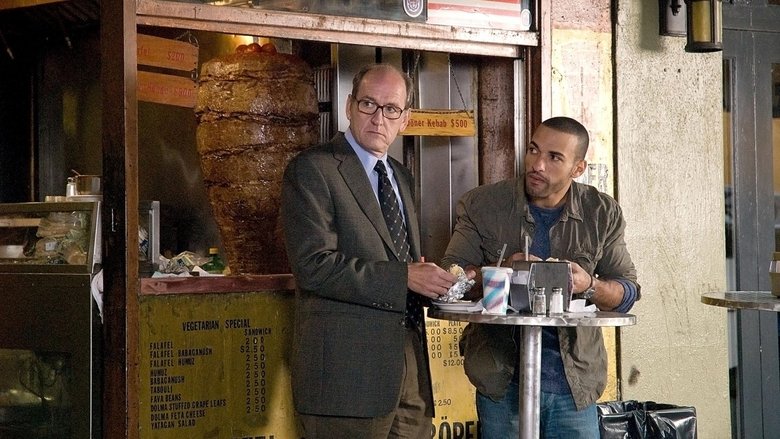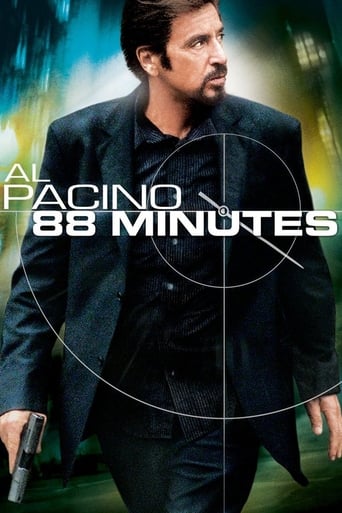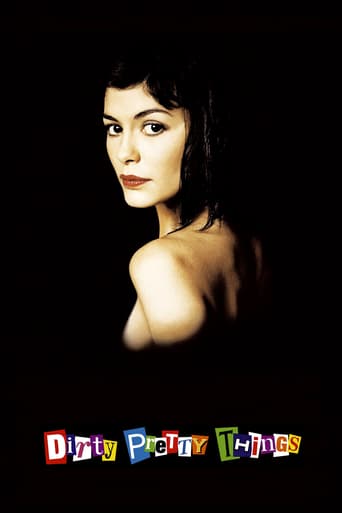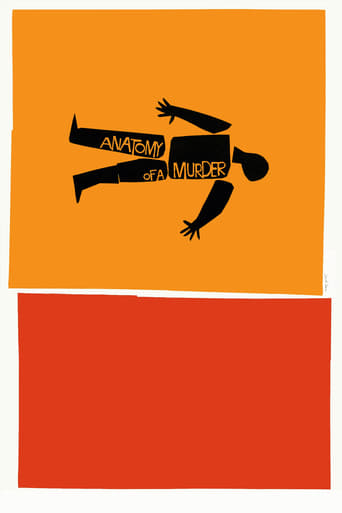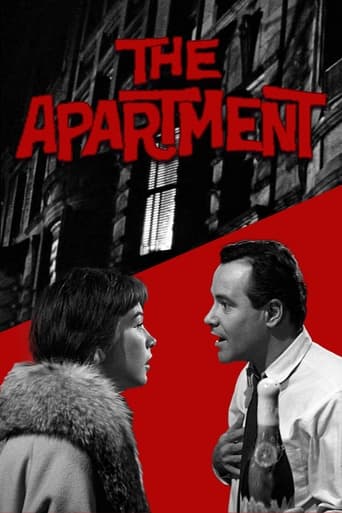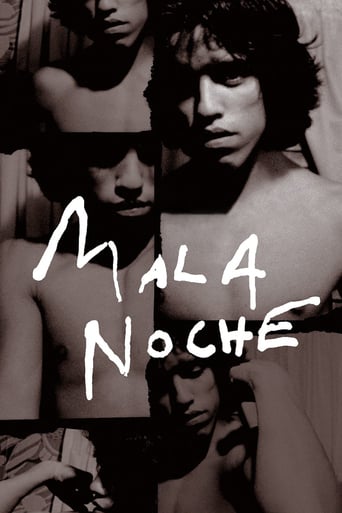The Visitor (2008)
A college professor travels to New York City to attend a conference and finds a young couple living in his apartment.
Watch Trailer
Cast


Similar titles
Reviews
Save your money for something good and enjoyable
Powerful
How sad is this?
The story, direction, characters, and writing/dialogue is akin to taking a tranquilizer shot to the neck, but everything else was so well done.
The film, The Visitor, opens with economics professor, Walter Vale, "auditioning" his fourth and final piano teacher. Walter, the widower of an accomplished classical pianist, tries to fill the void in his spiritless existence with the soundtrack of his favorite piano pieces; he proves ultimately unsuccessful in this venture. For several years, Walter had grown accustomed to the nightly ritual of eating alone, drinking a glass of red wine, and playing the bits and pieces of piano selections he had learned over time. Walter seems frozen in time, almost sleepwalking through his life. It is as if he is "visiting" his own life. Walter does not rest comfortably in his own skin, living what Oprah Winfrey refers to as his "best life." Walter resides there physically, but not emotionally or psychically. He is emotionally detached from the world he inhabits. Walter would prefer to insulate himself from the world by pretending to be busily preparing his fourth manuscript. A professional conference at N.Y.U. forces Walter out of the "ivory tower" into Manhattan, where with the help of his unexpected guide, Tarek Khalil, he faces the past, present, and future. Prior to meeting his new teacher, Walter had spent many years away from the Greenwich Village apartment he had once shared with his deceased wife. Upon returning to the apartment, Walter encounters two immigrants, Tarek (Syria) and Zainab (Senegal), living in his apartment as a result of a rent scam orchestrated by Ivan, a character we never see on camera. On the surface, these two "visitors" in Walter's life are living a much more fulfilled life than Walter. We soon discover that Tarek, a "citizen of the world," embraces people of all nationalities, ethnicities, and socio-economic, and religious backgrounds. In short, Tarek symbolizes our pre 9/11 America and its more tolerant attitude toward cultural diversity, and inclusiveness. This stands in direct contrast to the post 9/11, antagonistic, and suspicious view of immigrants who are seen as a threat to our sense of what it means to be an American. As Americans, we now feel forced to stand unified against future threats to our country. Before the horrific events on September 11, 2001, the concept of American pluralism was an unspoken "social contract" between Americans and any immigrant who reached our shores. This sentiment is best expressed by Emma Lazarus's words on the base of the Statue of Liberty, " Give me your tired, your poor, your huddled masses yearning to breathe free ." Walter, a native born American who not only has not visited the Statue of Liberty in person, is also unaware that visitors after 9/11 can no longer take the elevator to the top of Lady Liberty's crown. Not coincidentally, Tarek arrived in America prior to 9/11, and Zainab immigrated afterward. Their attitude towards their adopted country is reflected by this important distinction. In both cases, Tarek and Zainab enjoyed taking the Staten Island Ferry to view the Statue of Liberty. As Zainab recalled, Tarek would excitedly point to lady Liberty as a beacon of hope upon every viewing. Walter had never visited the Statue until accompanied by his two immigrant friends, Mouna and Zainab. As a well-educated, well-respected American, Walter did not need a symbol of liberty to reassure him of his place in America. Walter never had to question the inalienable rights granted to him by his forefathers, namely life, liberty, and the pursuit of happiness. In his pursuit of happiness, Walter is freed from a self-imposed prison of malaise and despair when he befriends Tarek, who "teaches" him about life by giving him lessons on the djembe, an African drum. These drum lessons and Tarek's positive, life-affirming attitude fully transform Walter from a rigid, inflexible, emotionally shut down individual into a caring, thoughtful, sensitive "student" of life. Walter happily replaces the solitude of playing the piano with the collaborative nature of the drum circles in the park. The Visitor is an excellent film that challenges our notions of how America can reconcile the longstanding debate on immigration. Who are the real visitors to this country, both native and non-native born, and who have settled here and enriched our lives with their presence? Most importantly, who is to determine which immigrants should stay, and how can we ensure that this process upholds our principles of justice, fairness, equality, and liberty for all? The Visitor reminds us of some important lessons. We were not attacked on 9/11 by immigrants who already lived within and contributed to our country's success. We were attacked by well-financed terrorist groups that operated outside our country. Instead of indiscriminately turning our attacks inward, we need to be spending the resources to ameliorate the myriad of foreign policy choices that prompted the terrorist attack in the first place.
A lonely old man, who lost his wife always pretend to be busy for work. One day he goes on a business trip to New York and meets a young couple. The man and the couple accidentally live in a house together. A young man loves to play music and tell the old man how to play kindly. The old man gradually comes to open his heart to the couple. However, the couple are immigrants and they actually live in New York illegally so they are taken by police. The old man tries to make the couple be free and goes to a detention house to meet them every day.This is a human drama and was released in 2007 in America. The director is Thomas McCarthy, who is an American director. Also, Richard Jenkins played the role of leading actor for the first time in this movie. I was so impressed by the movie, especially by the part of the kindness of the couple. Many innocent people like them are taken because of racial problems. We have to think the problem more seriously by watching this movie.
The Visitor is a film that is bigger than it was meant to be. It's a film that was bound to touch a number of hearts, including mine. It's a small-budget film with a simple and quite heartfelt story. The movie tackles strong post-9/11 issues such as illegal immigration and the United States ruthless deportation laws. The film also goes a long way to showing that not all foreign people are terrorists and that some are actually decent human beings and that because they are foreign, lots of assumptions and misunderstandings begin to ensue.Thomas McCarthy's film is about a middle-aged man named Walter Vale who has given up on life after his wife passed away. He is a teacher who has been teaching the same class for years and is also a big fan of music. When he goes to New York City for business, he runs into these two people who are somehow living in his apartment. But he strikes a bond with them. When one of the tenants, Tarek is about to be deported: Walter tries all he can to save his new friend.The acting is really good. The only well-known actor here is Richard Jenkins, who finally gets to shine in a leading role. He plays his character to perfection. He makes a transformation from a near unlikable man to a man who has found a will to live again. Another good performance here was from Hiam Abbass as Mouna, Tarek's mother. She delivers a heartfelt performance as the woman who experienced similar issues back in Syria.Overall, The Visitor is an excellent movie that relies upon heavy characterization. The authenticity is remarkable, and it goes to show that not all foreign people are evil monsters. Unfortunately, this is what 9/11 did to the United States. The look of the film is great and I loved the music, especially with the use of the African drums. It's a very small film, but one that deserves to be seen. I rate this film 9/10.
In 2008, Tom McCarthy crafted The Visitor by writing and directing a piece of cinema that examines the social temperature in the United States in a post-911 world. At the core of this film is the political issue of immigration, but The Visitor investigates the social, humanistic stripes of that issue using the supporting foreign roles to further develop and evolve the American protagonist. Walter, the film's leading character, is pulled out of his widower slumber by forming relationships with immigrant characters. The investment McCarthy places on his characters and the ways in which the supporting foreign roles impact the American protagonist is the path in which he leads the viewer to recognize the issue. The Visitor fully utilizes the potential of its mise-en-scene to develop Walter's journey in relation to Tarek, Zinab, and Mouna, which is encapsulated through motifs of music and the use of blue colors to describe different types of unity.At the heart of The Visitor is Walter. The film never verbally informs us of significant events in Walter's past, but all the necessary information to understand the plot is implied through the visuals. Walter's past is a key component in understanding how and why he changes during the film after he meets Tarek, Zinab, and Mouna.One of the most invaluable plot devices in The Visitor concerning Walter's characterization is music. He looks to music as something that can cure his soul and bring him closer to a connection, which at first he looks for in his wife's memory. Walter's wife was a very skilled pianist, and Walter, clinging for the company of someone or the comfort of his deceased wife, attempts to learn the piano. His inability to master the instrument leads his piano teacher to tell him that, "Learning an instrument at your age is difficult, " emblematically, this dialogue suggests that learning to play the piano to further connect to his wife is not going to fulfill Walter's loneliness.Once he goes to New York and meets Tarek, Walter begins to show interest in the African street drum, a non- traditional instrument for a conventional American like Walter. Tarek is patient with teaching him, and eventually Walter learns to play the drums comfortably. Forming such a deep friendship with Tarek is atypical for someone Walter's age and ideology, and by learning to play Tarek's drum, this symbolizes Walter adapting to Tarek's culture, growing personally, and becoming happier from that. The first scene in which the awkwardness dissipates between Walter and Tarek is the scene where Tarek offers to teach Walter how to play the drums. Music is the catalyst that brings Walter and Tarek closer together. Once these characters come into Walter's world, the slow, graceful, tranquil beat of classical music is shaken awake by the fervent, noisy, vibrant drums.The Visitor is about the characters relating to one another, and a way in which McCarthy does this is by using a themed color of clothing to describe the unity between Walter and the foreign people he meets in the story. The color blue comes to represent Watler, because in nearly every scene, he appears in a blue dress shirt underneath his suit jackets.The color blue unites Tarek and Walter on a human scale. Tarek is almost exclusively seen in a darker blue, navy shirt. Before he is confined to the correction center and even his uniform in the detention center is the same navy shade of blue. They may not be identically the same, Walter wears a lighter hue of blue than Tarek, but the colors are still blue.The color blue is most notably memorable for being the primary color used in the mural of New York City on the wall in the detention. In this mural is a blue-colored skyline of the city, as well as images of the American flag and the statue of liberty, both of which are items that represent freedom. The flag and statute of liberty however are not painted in blue. Though Tarek is an illegal immigrant and Walter is American, they are both still humans who contribute to the Untied States, which is represented in the non-specific city buildings in the detention center mural, as they are painted in blue. However, Walter has his freedom, Tarek does not. Freedom within the United States is more than just being a human who contributes to society, like the paintings of the Statute of Liberty and the American flag, which represent categorical freedom, use more colors than just blue.A piece of imagery that aptly concludes the investigation into Walter's character development based on the mise-en-scene in The Visitor is the immediate shot on the ferry of Walter with Mouna and Zinab. Closer in the frame are the three characters standing against the railing of the boat, and behind them lies a wide shot of New York City. In this shot, Walter is sailing away from the island with the new people in his life, figuratively leaving the old life behind. The Visitor is a process of personal growth for Walter, which is developed through the mise-en- scene subtly transcribing Walter's past and his evolution to the viewer through subtle clues, the importance of Walter's ability and inability play music, and the use of blue colors to unite characters of different ethnicities.


